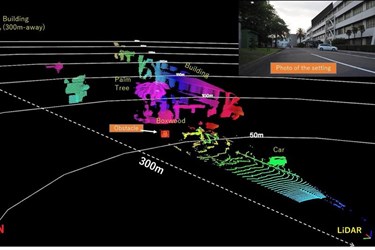LiDAR solution looks to address transportation infrastructure monitoring

Toshiba has unveiled an updated version of its solid-state LiDAR solution which now supports a maximum detection range of 200m and delivers much higher levels of resolution.
According to Toshiba, the upgraded performance of the LiDAR unit will help to accelerate the move towards autonomous driving and open up application opportunities for monitoring transportation infrastructure, in such areas as early detection of road subsidence or landslides, snow cover, or fallen objects on roads.
Current methods for monitoring transportation infrastructure rely on cameras, but their performance is degraded by low light levels and adverse weather conditions. Toshiba’s LiDAR unit offers an alternative delivering clear, long-distance, robust 3D scanning and object detection across a wide variety of lighting and weather conditions. It is also extremely compact, measuring only one-third the size of the earlier prototype announced back in July 2020, and is claimed by company to be the industry’s smallest on record.
“We have developed technologies essential for a compact, high-resolution, long-range solid-state LiDAR solution that is robust and simple to implement. Major demand for such a versatile solution is anticipated in both the autonomous driving and transportation infrastructure monitoring applications,” said Akihide Sai, Senior Research Scientist at Toshiba’s Corporate Research & Development Center. “We look forward to deploying this next generation LiDAR unit in roadside installations.”
At the heart of the LiDAR unit are a number of innovations that Toshiba made to its silicon photo-multiplier (SiPM) light-receiving chips in order to enhance the image resolution attained.
Each SiPM consists of light-receiving cells controlled by transistors. The new chips have smaller Transistor modules, and eliminate the buffer layers protecting the transistors. Instead, newly developed insulating trenches are placed between the transistors and the light-receiving cells. The potential issue of reduced light sensitivity due to use of smaller transistors has been addressed via the addition of a high-withstand voltage section to raise the voltage input to the light-receiving cell.
These innovations have reduced the size of the SiPM by 75% while elevating its light sensitivity by 50% compared with the July 2020 predecessor. More SiPMs can now be arrayed in the same package – thereby boosting the resolution to 1200 x 80 pixels (which is a 4x improvement).
Above: Toshiba’s SiPM incorporates much smaller transistors, a high voltage input section, plus insulating trenches
Toshiba has also ensured that the new LiDAR unit exhibits greater durability that is essential for outdoor use in all weather conditions.
A temperature compensation mechanism automatically adjusts the voltage input applied to the light-receiving cells, in order to mitigate the effect of external temperature changes. This means that heightened SiPM performance is maintained despite any ambient temperature fluctuations. In addition, by utilizing a high-density component mounting, Toshiba has reduced the overall size of the LiDAR projector and receiver to a 350cc volume.